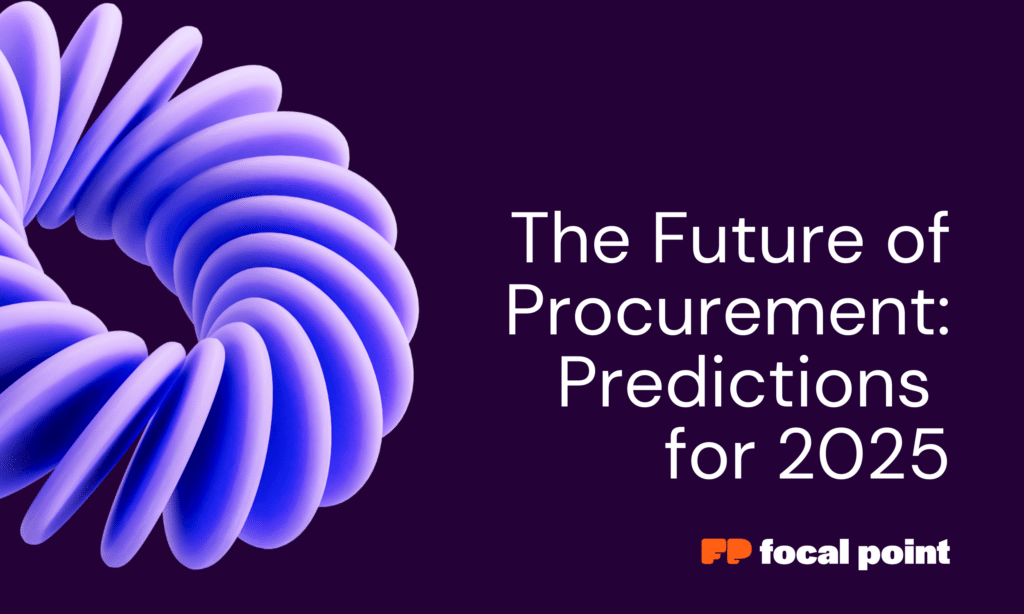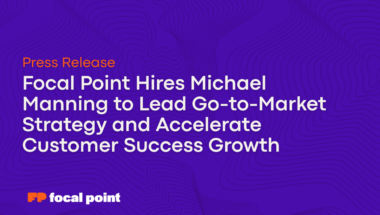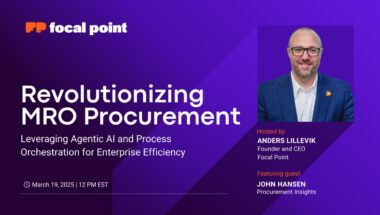Did you know that 66% of procurement leaders believe growing regulatory and ESG demands will heavily influence strategic sourcing decisions in the next 3-5 years? This striking statistic from KPMG’s recent survey highlights the transformative shifts awaiting the procurement landscape as we approach 2025.
We’re witnessing a pivotal moment in procurement history: as we look ahead to 2025, the industry is poised for changes driven by digital transformation and AI. Procurement’s traditional role as a cost-cutting function is evolving into a strategic powerhouse, helping organizations balance profitability with sustainability goals.
SAP Ariba’s Procurement 2025 vision predicts a future where procurement professionals shift from tactical work to strategic decision-making. This transition is fueled by intelligent systems that provide personalized experiences and automate routine tasks. All of this means more free time for value-creation activities for procurement leaders and their teams.
In this article, we’ll dive into the key procurement trends shaping the industry’s future. We’ll also examine the growing importance of sustainability in strategic sourcing. These changes will redefine procurement’s role in driving business success.
Table of Contents:
- State of Procurement in 2024
- AI and The Digital Transformation Revolution will Continue
- We'll Evolve from AI Adoption to True Integration
- Diverse Digital Transformation Technologies will Become the Norm
- Necessary Skills Will Continue to Evolve Alongside AI Integration
- Procurement will Continue to Evolve to Become More Strategic
- We'll See More Emphasis on Category Management Innovation
- Risk Management and Resilience will continue to be a Priority
- ESG Metrics will Increase In Importance for Procurement
- Supplier Collaboration will become Key for Achieving Sustainable Procurement
- The Procurement Workforce will Continue to Transform
- Future of Procurement: Operational Excellence and Innovation
- Data-Driven Decision Making Will Become More Critical
- Summary
- FAQ
State of Procurement in 2024
The procurement landscape in 2024 has undergone a significant shift. We’ve witnessed a rise in digital transformation and AI adoption across the industry. Procurement teams are now expected to drive strategic value and defend against disruptions in an increasingly complex business environment.
2025 marks a major turning point in procurement strategies. With the focus shifting from traditional cost-cutting to strategic value creation, sustainability and AI integration are becoming central to procurement processes. Forecasts predict global AI adoption in procurement will reach $1.3 billion by 2024, with 84% of business leaders planning to use conversational AI.
Several key factors are reshaping procurement:
- Digital transformation: Cloud-based technologies are gaining traction
- AI adoption: AI is transforming operations with data-driven insights
- Sustainability focus: ESG considerations are becoming paramount
- Risk management: Cybersecurity threats are on the rise, with projected damages of $10.5 trillion by 2025
These transformational forces are reshaping the procurement function, driving innovation and strategic value creation across industries.
AI and The Digital Transformation Revolution will Continue
The procurement landscape is radically shifting as AI in procurement and digital transformation reshape operations. We’re witnessing a surge in AI-powered procurement software, with industry leaders ramping up investments in cutting-edge technologies.
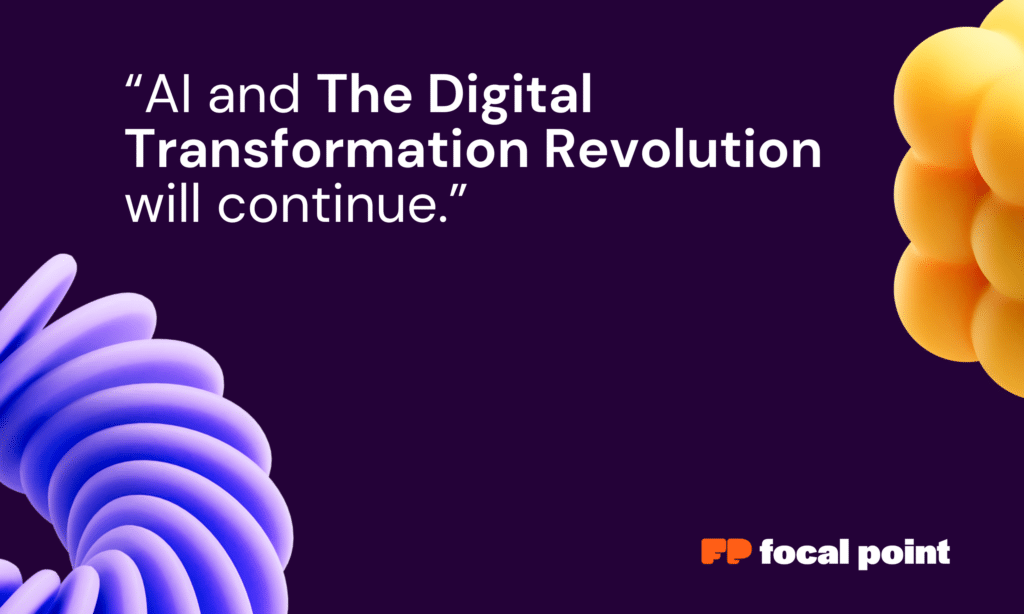
Digital transformation is not just a buzzword; it’s a reality. By 2025, global spending on digital supply chain technologies is projected to exceed $19 billion annually. This investment is driving automation and enhancing data analytics capabilities across the procurement sector.
Machine learning is at the forefront of this revolution. Gartner predicts that 50% of large global companies will implement AI, advanced analytics, and IoT in their supply chains by 2025. This integration is creating interconnected AI-driven value chains, transforming entire industries beyond isolated projects.
The impact of AI extends throughout the procurement process:
- Demand forecasting
- Inventory optimization
- Supplier management
- Distribution planning
- Sales and promotions strategy
As we move towards 2025, the focus is shifting from siloed solutions to end-to-end business applications. This transition is creating new efficiencies and insights, driving procurement from a cost center to a value creator.
While the benefits are clear, concerns about data security and potential leaks are rising, so to help mitigate these risks, a balanced approach to implementation is critical.
We’ll Evolve from AI Adoption to True Integration
AI integration in procurement processes is already rapidly transforming the industry. A staggering 94% of business executives believe AI will enhance their operations in the next five years. This shift is evident in the widespread adoption of AI-powered tools across various business functions.
And AI-powered tools are making significant inroads in procurement automation. 73% of businesses are using or planning to implement AI chatbots for instant messaging. Also, 61% leverage AI for email optimization, while 55% use it for personalized services like product recommendations.
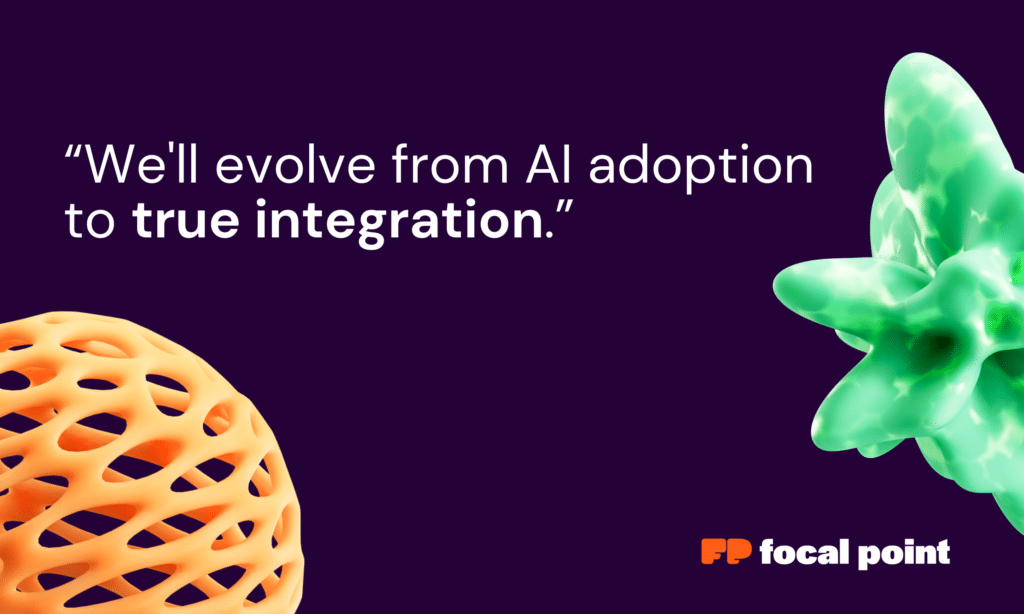
AI’s impact on procurement is varied, but nearly every aspect of the function has adopted some sort of AI solution. A few examples include:
- Enhanced data analytics for real-time insights and informed decision-making
- AI-powered spend analysis to identify inefficiencies and reduce costs
- Forecasting and demand planning using historical data and market trends
- Risk management through continuous monitoring of supplier data
- Compliance monitoring to adhere to procurement regulations
Despite the varied benefits, data privacy remains a concern with AI tools. Over 25% of companies have banned generative AI tools due to privacy issues. 63% restrict the types of data employees can input into AI systems, while 61% limit the AI tools that can be used. As AI integration deepens, striking a balance between innovation and data protection will be critical for successful procurement automation.
Diverse Digital Transformation Technologies will Become the Norm
Cloud procurement systems, blockchain, and predictive analytics are leading procurement’s digital transformation. They’re boosting efficiency, transparency, and strategic decision-making for procurement leaders and their teams.
Cloud-based Procurement Systems
Cloud procurement solutions offer scalability and real-time collaboration. They enable quick responses to market shifts and cut costs. By 2025, these systems will be the norm, allowing teams to access data and tools anytime, anywhere.
Blockchain Applications
Blockchain technology boosts transparency and traceability within supply chains. It creates a secure, unchangeable record of transactions, reducing risk and potential fraud and building trust. Companies might use blockchain for things like smart contracts and automated payments, making procurement smoother.
Predictive Analytics
Predictive analytics is quickly transforming procurement strategies. By analyzing historical data and trends, teams can forecast demand more accurately. This leads to smarter purchasing, reduced costs, and better inventory management.
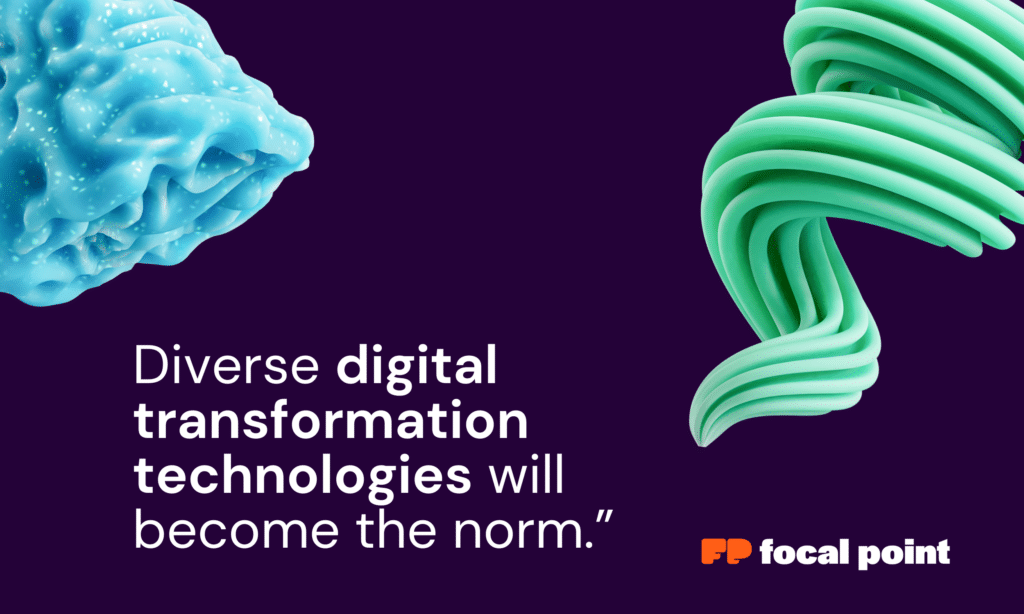
Unified Data Layer Benefits
A unified data layer offers complete visibility across operations. It merges data from various sources, giving a comprehensive view of procurement. This unification enables better decision-making and cost savings and is a radical shift from the many disparate point-solutions many teams have used historically.
Integration Capabilities
System integration is vital for a comprehensive procurement ecosystem. Seamless integration with ERP and CRM systems improves coordination and data flow. This integration is crucial for realizing digital transformation’s full potential.
Necessary Skills Will Continue to Evolve Alongside AI Integration
As the procurement landscape evolves, effective organizations demand a fresh set of skills for professionals in 2025. As AI reshapes the industry, we’re witnessing a surge in the need for data analysis expertise and strategic thinking abilities.
AI Management and Data Interpretation
In the coming years, procurement professionals will need to master AI management and data interpretation. These skills are crucial for leveraging AI-driven insights and making informed decisions. Strategic thinking will become even more vital as teams navigate complex supplier relationships and market dynamics.
Training and Adaptation Strategies
To prepare for this AI-driven future, organizations are implementing comprehensive AI training programs. These initiatives focus on safe AI experimentation and hands-on learning experiences. By 2025, we expect 62% of AI tool adoption to occur within the first five months of implementation, highlighting the importance of quick adaptation.
Balancing Human Expertise with AI Capabilities
Successful human-AI collaboration in procurement requires a delicate balance. Teams must align AI strategies with procurement goals while preserving human judgment. This approach ensures that AI enhances rather than replaces human expertise, leading to more effective decision-making and supplier management.
Success Metrics and Benchmarks
To measure the impact of AI integration, procurement teams are developing new performance metrics. These include:
- Improved efficiency in procurement processes
- Cost savings through AI-driven insights
- Enhanced supplier relationship management
- Increased accuracy in demand forecasting
By 2025, we anticipate AI spending in procurement to grow by 446%, far outpacing traditional SaaS tool growth. This shift underscores the transformative potential of AI in reshaping procurement practices and driving value creation.
Procurement will Continue to Evolve to Become More Strategic
Procurement pros know that strategic procurement has evolved beyond mere cost-cutting. As the function evolves to focus on creating value throughout the supply chain, we’re seeing a rise in long-term partnerships that emphasize innovation, reliability, and risk mitigation.
The digital technologies we’ve discussed are driving this transformation. They offer access to previously unavailable data and enable more complex analysis. This data-driven approach is revolutionizing procurement strategy, enabling proactive decision-making and scenario prediction.

By 2025, we anticipate a 14% compound annual growth rate in E-Sourcing platform spending. This growth highlights the increasing role of digital tools in procurement strategy. These tools are not just boosting efficiency; they’re also fostering new forms of collaboration and innovation in supplier relationships.
Metrics for Measuring Value Creation
To assess the impact of strategic procurement, organizations are adopting new performance metrics. These metrics include:
- Cost savings percentages
- Innovation contributions
- Sustainability improvements
- Supplier relationship scores
Strategic Decision-Making Frameworks
Procurement teams are now using data-driven insights to inform strategic decisions. These frameworks encompass:
- Risk assessment models
- Long-term value considerations
- Cross-functional collaboration metrics
Role of Procurement in Business Strategy
Procurement’s influence on business strategy is growing. Chief Procurement Officers are now viewed as “chief value officers.” They drive value through:
- Business partnering initiatives
- Digital technology adoption
- Sustainability programs
We’ll See More Emphasis on Category Management Innovation
Category Management is becoming increasingly critical to the ‘strategic procurement’ conversation. With the right category strategies, procurement teams are capable of generating a lot of strategic value. This is reshaping how organizations handle their spend categories.
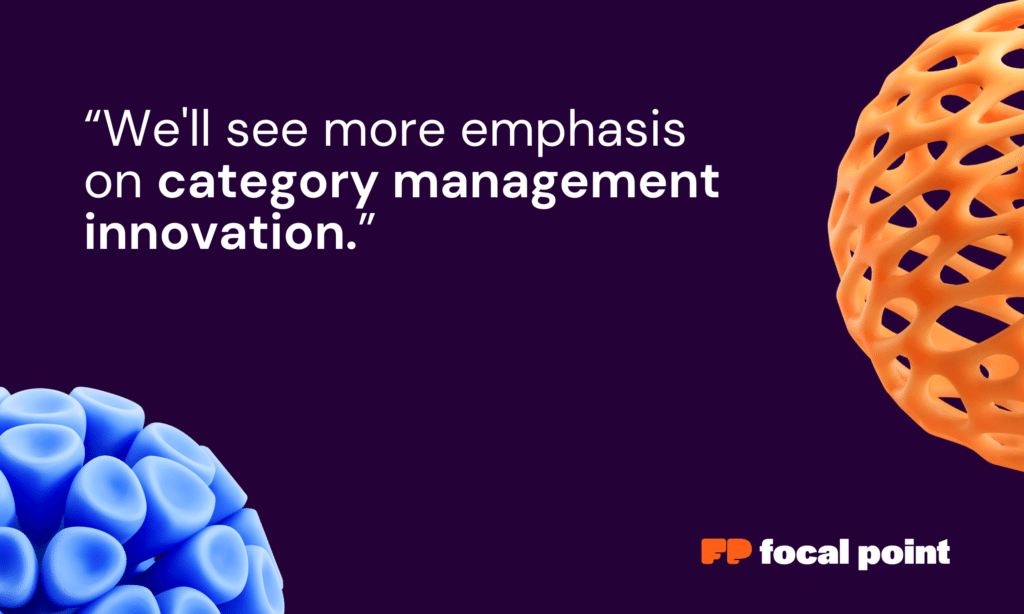
Technology-Enabled Category Management
The integration of built-for-purpose tools is revolutionizing category management. Analytics and business intelligence platforms are now essential for visualizing spend data and tracking performance metrics. These tools enable procurement teams to identify the crucial 20% of suppliers that typically account for 80% of total spend. This allows for more focused management strategies.
Cross-Functional Collaboration
Effective category management now requires increased collaboration across departments. Marketing procurement teams, for instance, are working closely with IT, finance, and legal to navigate complex operating environments. This cross-functional approach ensures that category strategies align with broader business goals and adapt to rapid market changes.
Data-Driven Category Strategies
Data-driven strategies are at the heart of modern category management. Procurement teams are using market intelligence metrics to understand spending patterns, track pricing trends, and assess risks. In categories like travel and fleet, these insights are crucial for preventing abusive spending behaviors and optimizing costs.
As we look towards 2024, the focus is shifting from traditional hard savings to new procurement KPIs. These emphasize creativity, agency performance, and conflict resolution. This evolution reflects a more nuanced approach to category management. It balances cost considerations with value creation and strategic alignment.
Risk Management and Resilience will continue to be a Priority
In today’s volatile business landscape, procurement risk management and supply chain resilience are paramount. Geopolitical risks, natural disasters, and market fluctuations pose significant challenges to organizations worldwide. Companies are turning to advanced technologies and strategies to enhance their risk assessment capabilities and strengthen their supply chains.
Geopolitical Risk Assessment
Geopolitical tensions have exposed the fragility of global supply chains. A staggering 67% of companies have faced complications in their procurement processes due to geopolitical factors. To mitigate these risks, organizations are developing comprehensive risk assessment frameworks. These frameworks categorize risks, create supplier and regional risk profiles, and regularly update assessments.
Supply Chain Diversification
Diversification is crucial for building resilient supply networks. 63% of companies have already implemented strategies outside of China, while an additional 10% are in the process of developing such plans. This approach helps reduce reliance on single sources and enhances overall supply chain resilience.
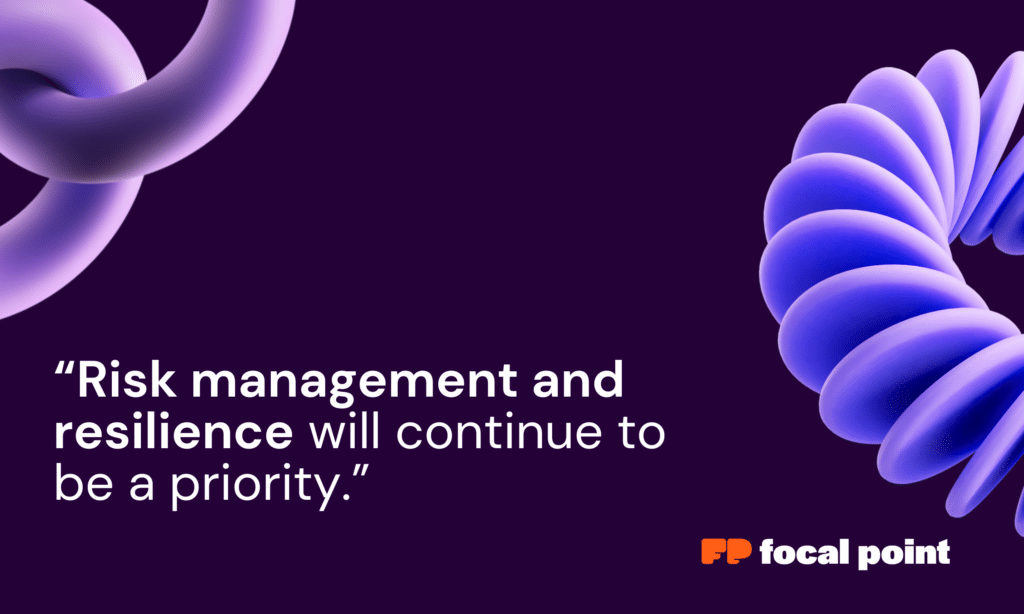
Predictive Risk Management Tools
Predictive analytics and AI are transforming procurement risk management. 66% of organizations now use these technologies for strategic supply chain decisions. These tools analyze vast amounts of data to forecast potential disruptions and recommend mitigation strategies. LevaData’s AI-powered platform, for example, offers real-time insights into supplier performance, financial health, and geopolitical risks.
Real-time Monitoring Capabilities
Effective risk management requires real-time visibility across the supply chain. 46% of companies aim to enhance visibility and communication throughout their value chain. By implementing advanced monitoring systems, organizations can quickly identify and respond to potential issues, thus improving overall supply chain resilience.
Sustainability and ESG Integration
Sustainable procurement will continue to be a hot topic in 2025. Companies will need to focus on suppliers who meet ESG standards. This change is driven by regulatory demands, consumer preferences, and the goal to reduce environmental harm while boosting brand image.
Recent data shows a clear trend towards ethical sourcing. An astonishing 80% of consumers are ready to spend more on eco-friendly products. This shift is compelling businesses to invest in sustainability software. McKinsey reports a 60% profit boost for those who do.
ESG integration in procurement goes beyond compliance; it’s about adding value. Sustainability software aids in managing carbon emissions, refining practices, and strengthening global reputation. It streamlines carbon tracking and reporting, essential for meeting global carbon standards.
Various sectors are benefiting from this approach. Non-profits, government bodies, the energy sector, retail, hospitality, healthcare, automotive, IT, construction, and finance are all seeing positive changes. By embracing ESG standards, these industries are not only reducing their ecological footprint but also gaining a competitive advantage globally.
ESG Metrics will Increase In Importance for Procurement
ESG metrics are becoming essential performance indicators in procurement. These metrics track supplier diversity, environmental impact, and social responsibility. By 2025, 80% of companies will include ESG factors in their procurement decisions.
Sustainable Sourcing Strategies
Sustainable sourcing is transforming supply chains. Companies now choose suppliers based on their ESG credentials. This approach not only reduces environmental impact but also mitigates risks from unethical practices.
Carbon Footprint Reduction
Carbon reduction is a priority for procurement teams. They’re implementing strategies to lower emissions in the supply chain. This includes selecting low-emission alternatives and promoting circular economy practices.
By embracing ESG procurement, companies discover that profit with purpose is not just possible but crucial for long-term success. This approach creates value for stakeholders and contributes to a more sustainable future.
Supplier Collaboration will become Key for Achieving Sustainable Procurement
Procurement teams are now focusing on supplier collaboration to drive sustainability innovation. This shift aligns with the growing importance of ESG reporting and the need for comprehensive supplier assessment frameworks.
Enhanced Supplier Assessment
Supplier assessment frameworks are undergoing a revolution. They now include detailed ESG criteria, enabling a more holistic evaluation of supplier performance. This approach helps identify areas for improvement and fosters a culture of continuous sustainability enhancement.
Driving Innovation Together
Collaborative innovation programs are becoming a cornerstone of supplier relationships. By working closely with suppliers, companies are co-creating sustainable solutions that benefit both parties. This partnership approach is key to addressing complex sustainability challenges and driving real change in supply chains.
Transparency Through ESG Reporting
ESG reporting and transparency are now standard requirements in procurement. We’re working hand-in-hand with suppliers to ensure accurate and comprehensive disclosure of sustainability metrics. This transparency not only meets regulatory demands but also builds trust with stakeholders and consumers.
The Procurement Workforce will Continue to Transform
The procurement workforce itself is also undergoing a significant transformation. As discussed, we’re witnessing a major shift towards digital skills and AI-driven processes. Organizations are adapting by creating diverse teams to handle modern procurement challenges.
A recent study indicates that 75% of workers now use AI tools at work. This trend is impacting the procurement sector, driving the need for new skills and organizational structures.
Talent management in procurement is becoming more complex. We’re seeing a rise in project-based work and flexible arrangements. This shift requires new approaches to recruitment, training, and retention.
Organizational change is necessary to keep up with these trends. Companies are breaking down silos and fostering innovation. They’re also investing in training programs to develop digital skills in their procurement teams.
| Skill | Importance in 2025 | Training Focus |
| AI and Machine Learning | High | Data analysis, predictive modeling |
| Digital Procurement Platforms | Critical | System integration, process automation |
| Sustainability Management | Growing | ESG metrics, sustainable sourcing |
| Risk Management | Essential | Predictive analytics, scenario planning |
As we move towards 2025, procurement teams must embrace these changes. By focusing on digital skills and adapting to new organizational structures, we can create a more agile and effective procurement workforce.
Future of Procurement: Operational Excellence and Innovation
Process Automation and Efficiency
Procurement teams are witnessing a transformative shift through workflow automation, with leaders experiencing up to a 25% increase in efficiency and a 60% reduction in manual processes.
Focal Point’s workflow automation capabilities provide enterprise-level functionality from a single window, eliminating the need to switch between multiple systems. Through its innovative Frames system, Focal Point consolidates every activity, person, vendor, contract, KPI, and dollar in one accessible location.
Focal Point’s workflow automation capabilities
The platform’s orchestration layer integrates seamlessly with existing processes, offering a unified space to manage all procurement needs without disruption. Teams can access everything from request management to supplier evaluation through specialized Frames, each pulling live data and workflow into organized spaces for thinking, planning, and doing.
No-code configuration benefits
Focal Point’s no-code configurations allow procurement teams to customize workflows without technical expertise, making it possible to adapt and evolve processes as needs change. This flexibility enables organizations to eliminate manual tasks and boost productivity without requiring extensive IT support or development resources.
Productivity improvement metrics
Organizations implementing these automation solutions have reported significant improvements, including:
- 25% increase in overall efficiency
- 60% reduction in manual processes
- Up to $550 million in documented cost savings
- Substantial reduction in time spent switching between systems
Data-Driven Decision Making Will Become More Critical
Unified data management
Focal Point centralizes procurement data into a single, unified platform, ensuring complete visibility across operations. This consolidation eliminates data silos and provides procurement teams with immediate access to critical information, enabling faster and more informed decision-making processes.
Analytics and reporting capabilities
The platform enriches, consolidates, and standardizes data, ensuring all information remains accurate and up-to-date. Through its comprehensive dashboard, teams can filter and analyze data by status, vendor, category, or stakeholder, providing deep insights into procurement operations and performance.
Performance measurement frameworks
The system enables continuous monitoring of key performance indicators through:
- Live data tracking in specialized Frames
- Real-time visibility into project status and progress
- Category-specific performance metrics
- Vendor performance tracking
- Savings and efficiency measurements
This integrated approach to operational excellence and innovation, powered by Focal Point’s technology, represents the biggest advancement in procurement technology since Excel, providing procurement teams with the tools they need to drive strategic value and operational efficiency.
Summary
As we approach 2025, the procurement landscape is undergoing a profound transformation driven by AI innovation, sustainability imperatives, and strategic evolution. Organizations that embrace this change by leveraging advanced platforms like Focal Point are positioned to thrive in this new era. With its unified workflow automation, data-driven insights, and seamless integration capabilities, Focal Point represents more than just a procurement solution—it’s a catalyst for operational excellence and strategic value creation.
As procurement teams navigate the complexities of ESG requirements, workforce transformation, and digital innovation, having the right technology partner becomes crucial. The future of procurement isn’t just about cost savings; it’s about creating sustainable value, fostering innovation, and driving strategic business outcomes. Those who adapt to this evolution today will lead the procurement revolution of tomorrow.
FAQ
How will AI impact procurement in 2025?
AI will revolutionize procurement, automating tasks like purchase orders and invoicing. It will also enhance contract management and offer insights for strategic decisions. Yet, companies must address data privacy concerns when implementing AI.
What are the key skills procurement professionals will need in 2025?
Procurement experts will need to master data analysis, AI management, and strategic thinking. They must develop digital skills and adapt to AI-driven processes. Balancing technical know-how with strategic vision will be crucial.
How is strategic procurement evolving towards 2025?
Strategic procurement is evolving from a cost focus to a value creation model. It emphasizes building long-term, value-driven relationships with suppliers. This shift involves prioritizing reliability, innovation, and risk mitigation, expanding procurement’s role in business decision-making.
What role will sustainability play in procurement by 2025?
Sustainability and ESG integration will be pivotal in procurement by 2025. Companies will seek suppliers that meet ESG standards and adopt sustainable sourcing. Reducing carbon footprint across the supply chain will be a priority, with ESG metrics in procurement KPIs.
How will risk management in procurement change by 2025?
Risk management will evolve with AI-driven analysis of global events for geopolitical risk assessment. Diversifying supply chains will reduce reliance on single sources. AI and big data predictive tools will forecast disruptions, enhancing risk management.
What technologies will drive digital transformation in procurement?
Digital transformation in procurement will be driven by cloud systems for scalability and collaboration, blockchain for transparency, and predictive analytics for demand forecasting. Integration will create comprehensive procurement ecosystems.
How will the procurement workforce change by 2025?
The procurement workforce will become more diverse and multi-generational. Retaining experienced workers for their knowledge while attracting digital natives for innovation will be key. Organizations will focus on creating agile, collaborative procurement functions.
What metrics will be used to measure procurement success in 2025?
Procurement success in 2025 will be measured by cost savings, innovation, sustainability, and value creation. ESG metrics will be integrated into KPIs, assessing supplier diversity and environmental impact.
